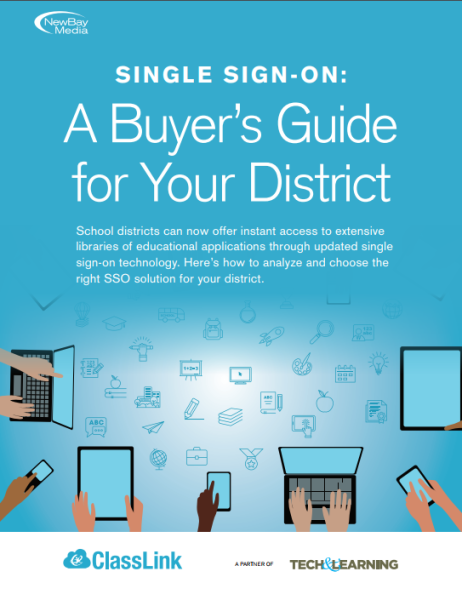Solving Critical Needs with SSO

Only 19% of schools have fully implemented SSO although it is the most popular interoperability initiative
—2017 CoSN K-12 IT Leadership Report
Single Sign-on (SSO) solves a critical need for districts that are managing increasingly complex digital ecosystems. SSO replaces the need for teachers and students to remember dozens of user names and passwords. It improves network security and decreases lost instructional time.
Every year, schools waste thousands of hours of instructional time by asking students and teachers to remember and sign in to an ever-increasing number of websites. As the number of digital educational resources increases, the problem grows exponentially. In addition, growing data security concerns and rostering requirements pose challenges for teachers and IT staff trying to get the most out of their technology tools.
The inability to quickly find and log into digital materials is an impediment to learning. Teachers and students waste valuable instruction time while some students are blocked from equitable access to instructional digital content and tools. Instead of experiencing all that digital learning resources can offer, students spend their time struggling to remember and physically type in usernames and passwords. This is more than frustrating at the individual level, and it’s a barrier to organization-wide adoption of digital learning—a barrier that single sign-on (SSO) can, and should, eliminate.
Keeping K–12 users secure in the evolving IT environment is also a major challenge. And as districts continue to embrace more web-based applications and bring thousands of mobile devices onto their networks, the problem gets progressively worse. In many cases, poor password selection, the large and ever-changing student user base, and the need for extensive user management on the part of a district’s IT team can all create cybersecurity issues. When students struggle to come up with and remember strong passwords, for example, the burden usually falls on the IT team to manage an overwhelming number of password reset and log-in problems.
Security and Analytics
Tools and ideas to transform education. Sign up below.
Spend more time learning; less time logging on

At Mountain Brook (AL) School System, Director of Technology Donna Williamson says the need for improved security drove the decision to invest in a web-based SSO solution. “Our previous solution was no longer meeting our needs,” says Williamson. “We knew we needed a new portal for security reasons and to give users 24/7 access, which is what they’ve become accustomed to with everything else in life.”
“When districts have a clear strategy in place for identity management,” says ClassLink’s VP of Education Success Kate Anastario, “the ability to establish and orchestrate a secure environment for students is much more attainable. By pulling users out of browser dependency—which they may not even be aware of—and allowing them to use one secure log-in, the cybersecurity vulnerabilities are significantly reduced.”
The ClassLink SSO platform incorporates analytic capabilities that can help districts understand whether and how frequently their learning and productivity resources are being used. The platform also provides details including who is logging in and what applications are being used.
Anna Baldwin, director of e-learning and integration at Anderson (SC) School District Five, says ClassLink Analytics helps the district assess the applications and software that it has purchased to see how those investments are being used. “We can look within our SSO platform and instantly get data that tells us whether students and teachers are using the products we bought. With a click we can summarize the charts on a daily, weekly, monthly, or whole-year basis to determine if there are schools that have less usage,” Baldwin says. “That data helps us really get the full bang for our buck across all of our software purchases.”
Rostering and Data Privacy
Historically, school technology departments have spent the months of July and August extracting class roster data from their student information systems and then creating unique data files for each digital resource. In most cases, the resource providers require essentially the same data. Unfortunately, they often require this data in unique formats, usually in the form of different spreadsheets and CSV files.
A group of committed school technology leaders and major education publishers came together, through the IMS Global Learning Consortium, and developed a new data standard called OneRoster. This data standard is a common file format for those roster data files. Using OneRoster, school data teams create one data file—and that same file is accepted by all publishers. What used to be a laborious, time-intensive, and repetitive exercise is now a streamlined process that benefits schools and the providers that serve them. ClassLink Roster Server simplifies the rostering process with publishers, ensuring students and teachers have instant access to the digital learning resources they need to improve learning.
For more information on Single Sign-on, download the Single Sign-on Buyer’s Guide. You will find a full description of the technology and 12 questions to help you evaluate potential SSO providers.
